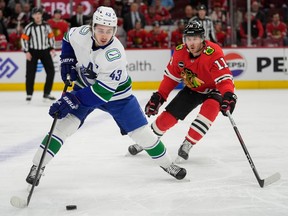A few simple numbers that tell us nothing lasts forever — in a good way

Article content
The Vancouver Canucks’ recent slump has been about struggles to defend more than anything else.
Advertisement 2
Article content
The results — more losses than fans have come to expect this season, especially blown leads — are born out by the underlying numbers.
Article content
Here’s a look at a few numbers that help us understand why the Canucks have been struggling, but also why those numbers are likely to turn around and the Canucks’ slump is likely to end.
89.2
You’ll only go as far as your best players will take you.
Much of the time, that’s up to them.
But some of the time, that’s outside of their control.
Take Quinn Hughes. The Canucks’ captain certainly hasn’t been as productive since the All-Star break as he has been on the bulk of the season.
One of those signs is the Canucks’ save percentage while he’s been on the ice at five on five.
Since the All-Star break it’s just 89.2 per cent.
Article content
Advertisement 3
Article content
His career on-ice save percentage is 91.2 per cent.
Past research by JFreshHockey has found that a lot of a player’s on-ice shooting and save percentages come down to luck.
It’s thus useful to compare the current with a broader baseline.
We can see, for one reason or another, that Hughes of late has been below his historical defensive norm.
And so it’s safe to say that Hughes will return to his defensive norm and the Canucks, who are have Hughes playing 20 minutes per game at even strength, will benefit.
152
How important is Hughes to the Canucks, by the way? Of the 152 goals the Canucks have scored at five on five this season, exactly half (76), have been scored with Hughes on the ice.
They’ve also given up just 46 five on five goals this season with Hughes on the ice.
Advertisement 4
Article content
Again: where Hughes’ game goes, so do the Canucks.
3
Natural Stat Trick‘s high-danger scoring chances is a flawed metric.
It doesn’t incorporate things like where the puck was passed from before the shot, whether there were people between the shooter and the goalie when the shot was taken, what the goalie was doing in the moments before the shot, and so on.
It only tells us was a shot attempt taken from in close and in front of the net, where the probability of a goal is generally high.
That final part is its utility. It tells us how well a team is getting to the net.
And on Tuesday in Los Angeles, the Canucks limited the Kings to just three high-danger chances all game. It was the first time since Jan. 27 versus Columbus, that they limited the opposition to so few chances.
Advertisement 5
Article content
One of those chances was Alex Turcotte’s two-on-one chance in the third period, where Thatcher Demko robbed Turcotte on a cross-crease pass. (Notably, a later chance by Trevor Lewis hit the side of the net and wasn’t recorded as a high-danger chance, so you could say there were four high-danger chances against in that game, but that’s still not very many.)
The overall point, though, is the Canucks were giving too many of these chances away over the past month and it was hurting them.
That said, they’ve only given up double-digits in high-danger chances five times since Christmas; a true turnaround from before Christmas, when nearly 20 of their games had double-digit high-danger chances against.
The Canucks’ defensive play is improved and that’s why this recent dip did stand out.
Advertisement 6
Article content
Given the broader picture it’s reasonable to expect that Tuesday’s performance is what we’ll mostly see on the run out to the season.
14
There’s one bigger picture number that tells a lot about the Canucks’ success this season: they’ve only trailed going into the third period 14 times this season.
That’s the fewest in the league, before the Florida Panthers who have been in the same spot just 15 times.
The Canucks have been excellent all season at getting off on the right foot and keeping the pedal to the metal.
No team in the NHL has more first-period goals than the Canucks (74). No team has a better first-period for-against split than the Canucks: they’ve outscored their opponents by 27.
Furthermore, no team in the NHL has more goals in the first and second period combined — 156 goals — than the Canucks (Colorado is second with 154 goals, but no one else is really close).
Advertisement 7
Article content
Third periods have become a tighter affair overall for Vancouver. You can understand why head coach Rick Tocchet has been pressing his players so much about their attention to detail in the final frame, not just because of the recent poor run of results, but because that’s what playoff hockey is in general: high-pressure, tight-checking, high-stakes hockey.

Recommended from Editorial
Bookmark our website and support our journalism: Don’t miss the news you need to know — add VancouverSun.com and TheProvince.com to your bookmarks and sign up for our newsletters here.
You can also support our journalism by becoming a digital subscriber: For just $14 a month, you can get unlimited access to The Vancouver Sun, The Province, National Post and 13 other Canadian news sites. Support us by subscribing today: The Vancouver Sun | The Province.
Article content





